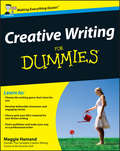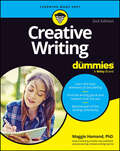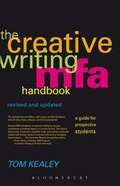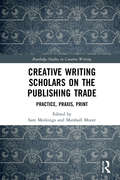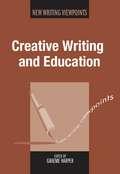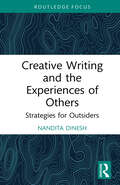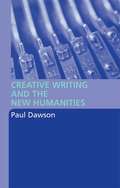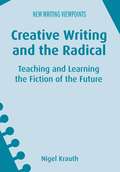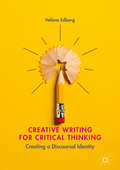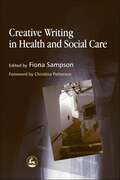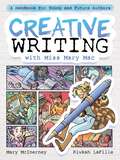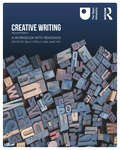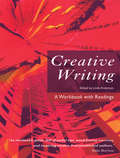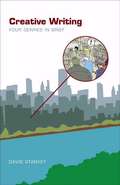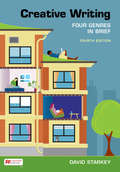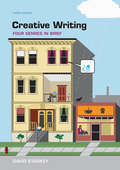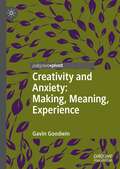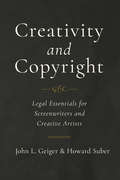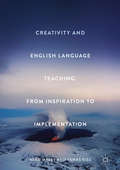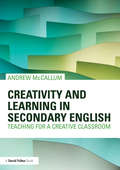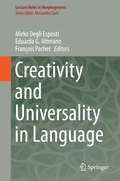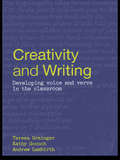- Table View
- List View
Creative Writing For Dummies
by Maggie HamandDo you have an idea that you’re burning to get down on paper? Do you want to document your travels to far-flung places, or write a few stanzas of poetry? Whether you dream of being a novelist, a travel writer, a poet, a playwright or a columnist, Creative Writing For Dummies shows you how to unlock your creativity and choose the genre of writing that suits you best. Walking you through characterisation, setting, dialogue and plot, as well as giving expert insights into both fiction and non-fiction, it’s the ideal launching pad to the world of creative writing. Creative Writing For Dummies covers: Part I: Getting started Chapter 1: Can Everyone Write? Chapter 2: Getting into the Write Mind Chapter 3: Finding the Material to work with Part II: The Elements of Creative Writing Chapter 4: Creating Characters Chapter 5: Discovering Dialogue Chapter 6: Who is telling the story? Chapter 7: Creating your own world Chapter 8: Plotting your way Chapter 9: Creating a Structure Chapter 10: Rewriting and editing Part III: Different Kinds of Fiction Writing Chapter 11: Short stories Chapter 12: Novels Chapter 13: Writing for children Chapter 14: Plays Chapter 15: Screenplays Chapter 16: Poetry Part IV: Different kinds of Non-fiction writing Chapter 17: Breaking into journalism - Writing articles/ magazine writing Chapter 18: Writing from life and autobiography Chapter 19: Embroidering the facts: Narrative non-fiction Chapter 20: Exploring the world from your armchair - Travel writing Chapter 21: Blogging – the new big thing Part V: Finding an audience Chapter 22: Finding editors/ publishers/ agents Chapter 23: Becoming a professional Part VI: Part of Tens Chapter 24: Ten top tips for writers Chapter 25: Ten ways to get noticed
Creative Writing For Dummies
by Maggie HamandUnlock your creative potential and write something special Ever dream of writing a book, article, poem, or play that means something to you—and maybe to someone else as well? Do you have an idea you're ready to get down on paper? In Creative Writing For Dummies, you'll learn how to unleash your creative side and become a confident and productive writer. Discover the essential elements of storytelling, including structure, characterization, setting, dialogue, and plot, as you navigate the countless ways you can express yourself with the written word. Explore the media and methods you can use to help find an audience—from traditional to self-publishing, social media, blogging, and more! Creative Writing For Dummies also shows you how to: Write in all sorts of different formats, including screenplays, scripts, creative nonfiction, poetry, short stories, novels, and beyond Navigate the world of social media and learn how it can contribute to getting your work read by more people in more places Understand the new, online nature of contemporary journalism and the proliferation of news and blogging sites A can't-miss roadmap to getting your first—or hundred-and-first—story, poem, or script committed to paper, Creative Writing For Dummies is an essential read for aspiring, amateur, and professional writers everywhere.
Creative Writing MFA Handbook: A Guide for Prospective Graduate Students (2nd Edition)
by Tom KealeyRevised and Updated! The Creative Writing MFA Handbook guides prospective graduate students through the difficult process of researching, applying to, and choosing graduate schools in creative writing. The handbook includes profiles of fifty creative writing programs, guidance through the application process, advice from current professors and students including George Saunders, Aimee Bender, Tracy K. Smith, and Geoffrey Wolff, and the most comprehensive listings of graduate writing programs in and outside the United States. The handbook also includes special sections about Low-Residency writing programs, Ph. D. programs, publishing in literary journals, and workshop and teaching advice. In a remarkably concise, user-friendly fashion,The Creative Writing MFA Handbook answers as many questions as possible, and is packed with information, advice, and experience. This second edition updates and builds upon the first edition, which was published in 2005 to great acclaim and contains a vastly expanded ranking of current creative writing programs.
Creative Writing Practice: Reflections on Form and Process
by Debra Adelaide Sarah AttfieldCreative Writing Practice: reflections on form and process explores the craft of creative writing by illuminating the practices of writers and writer-educators. Demonstrating solutions to problems in different forms and genres, the contributors draw on their professional and personal experiences to examine specific and practical challenges that writers must confront and solve in order to write. This book discusses a range of approaches to writing, such as the early working out of projects, the idea of experimentation, of narrative time, and of failure. With its strong focus on process, Creative Writing Practice is a valuable guide for students, scholars and practitioners of creative writing.
Creative Writing Scholars on the Publishing Trade: Practice, Praxis, Print (Routledge Studies in Creative Writing)
by Sam MeekingsIn Creative Writing Scholars on the Publishing Trade: Practice, Praxis, Print, Sam Meekings and Marshall Moore, along with prominent scholar-practitioners, undertake a critical examination of the intersection of creative writing scholarship and the publishing industry. Recent years have seen dramatic shifts within the publishing industry as well as rapid evolution and development in academic creative writing programs. This book addresses all of these core areas and transformations, such as the pros and cons of self-publishing versus traditional publishing, issues of diversity and representation within the publishing industry, digital transformations, and possible career pathways for writing students. It is crucial for creative writing pedagogy to deal with the issues raised by the sudden changes within the industry and this book will be of interest to creative writing students and practitioners as well as publishing students and professionals.
Creative Writing Workshop
by Miguel D'AddarioThe dream of writing a book for prosperity is one of the so-called purposes in life. They all write it down together with “plant a tree” and “have a child” and most will marry, breed offspring and participate in a reforestation campaign but… what about the book? We walk through a bookstore or visit an exhibition of books from around the world and we are surprised that someone is able to write stories, collect biographies of illustrious men… And even in movies, “diaries” seem to be the ideal of any young person captured on screen. Could it be that it is impossible to write this book in order to leave a mark of our passage in this world? Let me tell you yes. Yes it is possible.
Creative Writing and Education
by Graeme HarperThis book explores creative writing and its various relationships to education through a number of short, evocative chapters written by key players in the field. At times controversial, the book presents issues, ideas and pedagogic practices related to creative writing in and around education, with a focus on higher education. The volume aims to give the reader a sense of contemporary thinking and to provide some alternative points of view, offering examples of how those involved feel about the relationship between creative writing and education. Many of the contributors play notable roles in national and international organizations concerned with creative writing and education. The book also includes a Foreword by Philip Gross, who won the 2009 TS Eliot Prize for poetry.
Creative Writing and the Experiences of Others: Strategies for Outsiders (Routledge Focus on Literature)
by Nandita DineshIn times that are rife with complex manifestations of identity politics, writing classrooms across the world are hosting heated debates about what it means for authors to write about experiences outside their own. This book focuses on writing as the act of witnessing when the writers themselves were not present to witness in person. It seeks to answer the questions that come along with these experiences, such as what might it mean to write in order “to watch,” “to try and understand,” “to never look away,” and “to never forget” when the writer is an outsider to an experience? What might it mean to write about others in ways that do not essentialize or sensationalize, and in ways that are as humble, ethical, and responsible as possible? What might it mean to bear witness through the written word while engaged in a constant (re)negotiation with one’s own positioning i.e., to cultivate a condition of critical empathy that doesn’t also have the consequence of creative paralysis?
Creative Writing and the New Humanities
by Paul DawsonThis book examines the institutional history and disciplinary future of creative writing in the contemporary academy, looking well beyond the perennial questions 'can writing be taught?' and 'should writing be taught?'.Paul Dawson traces the emergence of creative writing alongside the new criticism in American universities; examines the writing workshop in relation to theories of creativity and literary criticism; and analyzes the evolution of creative writing pedagogy alongside and in response to the rise of 'theory' in America, England and Australia.Dawson argues that the discipline of creative writing developed as a series of pedagogic responses to the long-standing 'crisis' in literary studies. His polemical account provides a fresh perspective on the importance of creative writing to the emergence of the 'new humanities' and makes a major contribution to current debates about the role of the writer as public intellectual.
Creative Writing and the Radical: Teaching and Learning the Fiction of the Future
by Nigel KrauthThe rise of digital publishing and the ebook has opened up an array of possibilities for the writer working with innovation in mind. Creative Writing and the Radical uses an examination of how experimental writers in the past have explored the possibilities of multimodal writing to theorise the nature of writing fiction in the future. It is clear that experimental writers rehearsed for technological advances long before they were invented. Through an in-depth study of writers and their motivations, challenges and solutions, the author explores the shifts creative writing teachers and students will need to make in order to adapt to a new era of fiction writing and reading.
Creative Writing for Critical Thinking: Creating a Discoursal Identity
by Hélène EdbergThis book explores narrative imagination and emotion as resources for learning critical meta-reflection. The author examines the learning trajectories of several students as they engage in learning to think critically through a new approach to creative writing, and details how learning through writing is linked to new discoursal identities which are trialled in the writing process. In doing so, she analyses the processes of expansion and change that result from the negotiations involved in learning through writing. This volume offers a completely new approach to creative writing, including useful practical advice as well as a solid theoretical base. It is sure to appeal to students of creative writing and discourse analysis as well as applied linguistics and language as identity.
Creative Writing in Health and Social Care
by Fiona Sampson'This book is really a must-have for therapists and others in the creative arts, so that you can see how the workings of the human mind can be displayed through the arts. Even with serious illness, the mind can talk. And that is the point of the book'. - Metapsychology Online Book Reviews 'The references cited at the end of each chapter are instructive and useful with some contributors drawing on memoirs and creative work and others on textbooks and papers. As Fiona points out in her introduction, those with an interest in the field - which includes clinicians, patients, arts managers, psychotherapists, writers, occupational therapists, teachers - I am sure you can add to the list - inevitably speak different languages, reflecting their different priorities. I agree with her argument that this contributes to a healthy diversity of practice that may offer "something for everyone" and we should resist narrow definitions. The challenge for those of us in the field is to locate ourselves on this strange and exciting map and to chart our own experiences in whatever languages are appropriate. Conferences, such as Strange Baggage and the increasingly popular Lapidus annual event provide an excellent opportunity to journey beyond our usual borders to exchange travellers' tales with our colleagues'. - Lapidus 'An incisive collection of essays and case studies, where theory is applied to practical goals: working out methods for how to help and understand those with problems threatening their sanity or stability. Creative expression can contribute to personal and community health.' - Writing in Education 'Creative Writing in Health and Social Care is full of experience of working with patients with dementia, hospital, hospice and occupational therapy patients, and those in primary care. This is innovative work - deeply helpful to the patients, illuminatively described.' - The British Journal of General Practice This unique and comprehensive 'map' of the topic of creative writing in health and social care brings together contributions from health and social care professionals and provides the information needed to teach, counsel and write. Principally exploring poetry and story writing and telling, case studies range from work with pre-literate children in post-war Macedonia to people with dementia in Britain. Complementing these insights, theory-based contributions provide context, comparing different arts therapies using psychoanalytic and phenomenological theories of art and ideas, assessing the value of creative writing in a health care setting, examining methods of training therapists and looking at the aims of creative writing in terms of self development. This holistic approach ensures that Creative Writing in Health and Social Care is an essential guide for health care professionals and others seeking to use creative writing in therapeutic settings.
Creative Writing with Miss Mary Mac: A Handbook for Young and Future Authors
by Mary McInerneyWriting doesn’t have to be a chore! This graphic novel guide for aspiring writers will show you how to create your masterpiece.Authors are artists! But instead of putting paint on a canvas, they put words on a page. Writing coach Mary McInerney (aka Miss Mary Mac) will show you how to use words to express yourself—and have fun doing it!The writing exercises in this book aren’t what you’re used to! With Miss Mary Mac’s help, you can unlock your creativity, find inspiration all around you, and develop a voice that’s truly your own. When you use your imagination, writing is never boring. Follow the tips in this graphic novel guide and turn the page into your very own canvas.
Creative Writing: A Workbook with Readings
by Sally O’Reilly Jane YehCreative Writing: A Workbook with Readings provides a complete creative writing course: from ways to jump-start your writing and inspire your creativity, right through to presenting your work to agents and publishers. It covers the genres of fiction, poetry and life writing (including autobiography, biography and travel writing), combining discussions of technique with readings and exercises to guide you step by step towards becoming more adept at creative writing. The second edition has been updated and in large part newly written, with readings by a diverse group of contemporary authors displaying a variety of styles and approaches. Each chapter also features an array of inspiring writing exercises, enabling you to experiment with different methods and discover your strengths. Above all, Creative Writing: A Workbook with Readings will help you to develop your abilities while nurturing your individual voice as a writer.
Creative Writing: A Workbook with Readings
by Linda AndersonCreative Writing is a complete writing course that will jump-start your writing and guide you through your first steps towards publication. Suitable for use by students, tutors, writers’ groups or writers working alone, this book offers: a practical and inspiring section on the creative process, showing you how to stimulate your creativity and use your memory and experience in inventive ways in-depth coverage of the most popular forms of writing, in extended sections on fiction, poetry and life writing, including biography and autobiography, giving you practice in all three forms so that you might discover and develop your particular strengths a sensible, up-to-date guide to going public, to help you to edit your work to a professional standard and to identify and approach suitable publishers a distinctive collection of exciting exercises, spread throughout the workbook to spark your imagination and increase your technical flexibility and control a substantial array of illuminating readings, bringing together extracts from contemporary and classic writings in order to demonstrate a range of techniques that you can use or adapt in your own work. Creative Writing: A Workbook with Readings presents a unique opportunity to benefit from the advice and experience of a team of published authors who have also taught successful writing courses at a wide range of institutions, helping large numbers of new writers to develop their talents as well as their abilities to evaluate and polish their work to professional standards. These institutions include Lancaster University and the University of East Anglia, renowned as consistent producers of published writers.
Creative Writing: Four Genres in Brief
by David StarkeyHow can students with widely varied levels of literary experience learn to write poetry, fiction, creative nonfiction, and drama -- over the course of only one semester? In Creative Writing: Four Genres in Brief, David Starkey offers some solutions to the challenges of teaching the introductory creative writing course: (1) concise, accessible instruction in literary basics; (2) short models of literature to analyze, admire and emulate; (3) inventive and imaginative assignments that inspire and motivate.
Creative Writing: Four Genres in Brief
by David StarkeyCreative Writing: Four Genres in Brief offers concise, accessible instruction in the basics of writing poetry, fiction, creative nonfiction, and drama, providing short models of literature to analyze and emulate, plus inventive assignments to inspire and motivate you.
Creative Writing: Four Genres in Brief, 3rd Edition
by David StarkeyHow can students with widely varied levels of literary experience learn to write poetry, fiction, creative nonfiction, and drama -- over the course of only one semester? In Creative Writing: Four Genres in Brief, David Starkey offers some solutions to the challenges of teaching the introductory creative writing course: (1) concise, accessible instruction in the basics of writing poetry, fiction, creative nonfiction, and drama; (2) short models of literature to analyze, admire and emulate; (3) inventive and imaginative assignments that inspire and motivate. In the third edition, in response to reviewer requests, the literature and writing prompts have been significantly refreshed and expanded, while new treatment of getting published and the growing trend of hybrid creative writing have been added.
Creativity and Anxiety: Making, Meaning, Experience (Palgrave Studies in Creativity and Culture)
by Gavin GoodwinAnxiety is perhaps the defining psychological malady of our age, whereas creativity is seen as an almost unassailable good, its importance heralded and promoted in a range of disciplines and domains. A number of diverse thinkers and researchers have tried to unpick the relationship between anxiety and creativity, and this short book explores and connects some of their ideas and findings. Drawing on psychoanalysis and neuroscience, existential psychology and mindfulness, literary studies and philosophy, this book places a range of different disciplines in dialogue. It explores how creativity and anxiety might impact one another, and argues for the importance of establishing a diverse and inclusive cultural space which everyone can draw from and contribute to.
Creativity and Communication in Persons with Dementia
by Claire Craig John KillickProviding people with dementia with opportunities to engage in creative activity can play a crucial role in maintaining and enhancing communication, and in reinforcing personhood and identity. This thoughtful book describes how people with dementia, and the people who work with and care for them, can foster and develop a creative approach, and provides rich and varied ideas for creative activities. The authors explore the concept of creativity - what exactly it is, its particular relevance for people with dementia and how to get into the creative 'flow'. They introduce a range of creative art forms, including poetry and story-telling, collage, drama, music-making, photography, textiles and working with wood and metal, and suggest possibilities for employing them in a range of settings, and with people of all abilities. Consideration is given to the practicalities of facilitating such creative work, including how to organise and run sessions, how to involve people with dementia and their carers, and how to reflect upon the experience. Practice examples are included throughout the book, as well as the comments and observations of people with dementia, and many examples of the artwork and poetry the authors have created with people with dementia over the years. Brimming with ideas, suggestions and helpful guidance, this is an essential resource for all those who work with people with dementia, and an inspiring read for people with dementia and their families.
Creativity and Copyright: Legal Essentials for Screenwriters and Creative Artists
by Howard Suber John L. GeigerInspired by Strunk & White's The Elements of Style, this elegant, short reference is the perfect guide for screenwriters and creative artists looking to succeed as industry professionals. Readers will quickly understand the laws that govern creativity, idea-making, and selling, and learn how to protect themselves and their works from the legal quagmires they may encounter. Written by an unrivaled pair of experts, John L. Geiger and Howard Suber, who use real-life case studies to cover topics such as clearance, contracts, collaboration, and infringement, Creativity and Copyright is poised to become an indispensable resource for beginners and experts alike.
Creativity and English Language Teaching: From Inspiration to Implementation
by Alan Maley Tamas KissThis book offers a unique perspective on creativity in an educational environment where there is a relative dearth of literature on this subject. The authors link practice and principle to provide a practical and valuable guide for more creative language learning and teaching, using not only theoretical ideas but useful practical advice and recommendations on how better to introduce creativity into teaching and daily life. This innovative volume is sure to become a crucial reference point for teachers and practitioners of language teaching, and anyone interested in the ways in which creativity can be channelled into the teaching and learning process.
Creativity and Learning in Secondary English: Teaching for a creative classroom
by Andrew McCallumCreativity in secondary English lessons today is a democratically conceived quality that all pupils are expected to achieve and a resource on which all are entitled to draw. But what exactly is creativity? And how does it relate to English? Creativity and Learning in Secondary English answers these questions, and others, by arguing for a version of creativity that sees it as an ordinary, everyday part of successful classroom practice, central to processes of meaning-making, dialogic interaction and textual engagement. In this construction, creativity is not just linked to learning; it is the driving force behind learning itself, offering pupils the opportunity to transform their knowledge and understanding of the world around them. This book borrows from a range of theories about creativity and about learning, while remaining largely practical in focus. It contains numerous examples for teachers of how to apply ideas about creativity in the classroom. In doing so, it attempts to maintain the subject’s core identity while also keeping abreast of contemporary social, pedagogical and technological developments. The result is a refreshing challenge to some of the more mundane approaches to English teaching on offer in an age focussed excessively on standardisation and teaching to tests. Practical applications of creativity include: Using picture books and graphic novels to stimulate multimodal responses Placing pupils in the role of the teacher Devising marketing campaigns for class novels Adopting experimental approaches to redrafting Encouraging ‘extreme’ forms of re-creative writing Focusing on how to ‘listen’ to texts Creating sound-scapes for poems Thought-provoking and provocative, this textbook draws on current best practice in English teaching and will equip trainee and practising teachers with a wide range of strategies that will lead to greater creativity in the classroom.
Creativity and Universality in Language (Lecture Notes in Morphogenesis)
by Mirko Degli Esposti Eduardo G. Altmann François PachetThis book collects research contributions concerning quantitative approaches to characterize originality and universality in language. The target audience comprises researchers and experts in the field but the book may also be beneficial for graduate students. Creativity might be considered as a morphogenetic process combining universal features with originality. While quantitative methods applied to text and music reveal universal features of language and music, originality is a highly appreciated feature of authors, composers, and performers. In this framework, the different methods of traditional problems of authorship attribution and document classification provide important insights on how to quantify the unique features of authors, composers, and styles. Such unique features contrast, and are restricted by, universal signatures, such as scaling laws in word-frequency distribution, entropy measures, long-range correlations, among others. This interplay between innovation and universality is also an essential ingredient of methods for automatic text generation. Innovation in language becomes relevant when it is imitated and spread to other speakers and musicians. Modern digital databases provide new opportunities to characterize and model the creation and evolution of linguistic innovations on historical time scales, a particularly important example of the more general problem of spreading of innovations in complex social systems. This multidisciplinary book combines scientists from various different backgrounds interested in quantitative analysis of variations (synchronic and diachronic) in language and music. The aim is to obtain a deeper understanding of how originality emerges, can be quantified, and propagates.
Creativity and Writing: Developing Voice and Verve in the Classroom
by Kathy Goouch Andrew Lambirth Teresa GraingerThis clear yet authoritative book affirms the vital role of creativity in writing and considers and encourages flexible, innovative practices in teaching. Importantly, the book reflects upon teachers' imaginative and artistic involvement in the writing process as role models, collaborators, artists, and as writers themselves. Arguing that children's creative use of language is key to the development of language and literacy skills, this book focuses on the composition process and how children can express their own ideas. In addition, the authors consider the many forms of creative language that influence the inner and outer voice of children, including reading, investigating, talking and engaging in a range of inspiring activities. Illustrated throughout with many examples of children's writing and drawing, this book also provides suggestions for classroom activities and is a source of inspiration and practical guidance for any teacher looking to deepen their understanding of literacy theory and practice.
